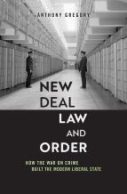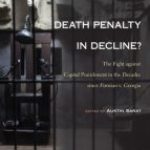New Deal Law and Order: How the War on Crime Built the Modern Liberal State
 Author: Anthony Gregory
Author: Anthony Gregory
Publisher: Harvard University Press, 2024. 512 pages.
Reviewer: Sheldon Evans | Winter 2025
After a hundred year’s war on crime, what have we learned? This provocative question is an underlying theme in Anthony Gregory’s New Deal Law and Order that haunts the deft reader. The title of this book is an accurate portrayal of the overall thesis, arguing that the crime policy of the New Deal era helped legitimize a specific brand of liberalism that continues to this day. And Gregory carefully leaves breadcrumbs for modern readers to trace the trail. While some of the forest gets lost for the trees in this 491-page volume, it is a worthwhile resource for students, scholars, and policymakers that want to understand the foundations of the war on crime and mass incarceration.
Gregory’s work builds on the political theory that crime policy is central to state building. Philosophers going back to Thomas Hobbes have argued that criminal law and punishment were among the primary justifications of state power. Modern scholars including Jonathan Simon and Corey Robin have explored how crime policy and fear of dangerous “others” lays the foundation of the modern state. New Deal Law and Order builds on these ideas with the meticulously researched case study of New Deal crime policy. In an era of economic instability, President Franklin D. Roosevelt was able to build a coalition of New Dealers that legitimized government power in social welfare and crime policy that continue on today.
Gregory achieves this contribution through the following five themes: (1) conceptualizing liberalism; (2) discussing bipartisan coalitions; (3) emphasizing the transformation of federalism; (4) studying specific substantive crime policies; and (5) characterizing the importance of rhetoric. Because of the sheer amount of material, there are indeed other themes and sub-themes weaved throughout the book. But I consider these five to be central to the story and ultimately the most important connections to the past that Gregory contributes to the historical literature.
Liberalism is the central theme of the book, which presents a few problems. Liberalism as a political ideology is the theoretical framework that is supposed to hold everything together in Gregory’s thesis. In order to argue that the New Deal’s brand of liberalism in crime policy laid the groundwork for the modern liberal state, we need to know what this term means. But Gregory’s attempts to define liberalism is what I found least convincing in this book. Gregory acknowledges that “liberalism eludes a fixed definition,” (9) yet still tries to convince the reader with definitions that evoke a mix of classical liberalism and political liberalism. First, he contends that “American liberalism [is] a political program seeking to balance freedom and social needs in pursuit of democratic stability.” (3) Next, he adds further “generalizations” by claiming that “[a]cross historical settings, liberalism has evinced an affinity toward human flourishing, equality of rights, commercial society, civilizational harmony across classes and trades, and state power directed and constrained by democratic voice and predictable legal principles.” (9) He also tries to define the “modern liberal state” as a “unity of welfare liberalism, carceral repression, and national security regimentation.” (3–4) Gregory’s descriptions of liberalism are accurate, yet too broad to be satisfying. This is the intellectual precarity of using such a big-tent term as “liberalism” (or “conservatism” for that matter) as a theoretical foundation: the ideology is so broad that anything and everything can fit under it. Liberalism has very little explanatory power because it is not the tent that is intellectually interesting; it is everything underneath the tent that is the real story. As I read New Deal Law and Order, liberalism is not the connective tissue between the past and present; rather, it is liberalism’s intersections with federalism, bipartisan coalitions, substantive crime policy, and harsh rhetoric that laid the foundation for the future. This is ultimately Gregory’s point: Roosevelt’s visionary administration changed and transformed liberalism through these tools. And thus, New Deal liberalism—specifically its use of crime policy—serves as a foundation for the modern liberal state. This critique does not diminish Gregory’s historical contribution, but rather questions the overall framework that relies on an unsatisfying political theory. For these reasons, I found myself dismissing much of the liberalism discussion and investing much more into the historical account. I believe this approach is more consistent with the style and archival research of the book.
The liberalism that Gregory evokes is broader than Left or Right politics because crime policy brought together Democrats and Republicans to create the New Dealer coalition. Crime policy of the New Deal transcended institutional divisions to create national ideological cohesion. (2) It was a tent that was big enough to include “organized labor, white southerners, [] Black Americans,” and “shared a constellation of values and practices . . . that also captivated much of the contemporaneous Republican Party.” (11) Indeed, the democratic mandate was so powerful that it gave New Deal Democrats the ability to shape the opposing Republican party throughout Roosevelt’s presidency. (10) Conservative support for police and lawmen, as well as Roosevelt’s willingness to work with Republican holdovers in his administration were meaningful in strengthening the New Dealer coalition. Administrators such as J. Edgar Hoover, who headed up the FBI, and Harry Anslinger, who headed up the Federal Bureau of Narcotics, both came to power under Roosevelt’s predecessor yet were allowed to keep their positions based on their ability to facilitate Roosevelt’s crime policies. This theme of bipartisanship in crime policy continues to this day, which Gregory broaches in his epilogue. “Mass incarceration and the modern war on drugs united Republicans and Democrats from Ronald Regan to Bill Clinton, Strom Thurmond to Joe Biden.” (349) When times get tough, the tradition of working across the aisle to get tough on crime appears to be a staple of American governance.
Gregory also details how New Dealers were pioneers in centralizing power in the federal government to combat economic and social anxiety. (21) Although crime is traditionally considered to be a local issue, Roosevelt nationalized crime policy by justifying it through his social welfare plans. New Dealers used the Commerce Clause to expand the federal criminal code, arguing that crime’s impacts on interstate commerce gave rise to federal jurisdiction. This move brilliantly connected the economic interests of the nation with crime policy, helping get markets back on track during the Great Depression. (110, 115) The federal government also provided funding to the states in cooperative programs to help their criminal systems crack down on crime. (10, 82) There was also direct federal coordination of interstate legislative and enforcement efforts, including work done by the Interstate Crime Commission; the Uniform Act on Interstate Extradition; and building a national database of fingerprints, automobile purchases, and drivers’ licenses. (134) These developments enshrined the ideal of a strong central government that enjoys clear supremacy over the states that has been an ongoing debate in Our Federalism since Reconstruction. And for those familiar with the tough-on-crime era of the 1980s and 1990s, the federal government’s expansion of its criminal code, funding state programs, and coordinating interstate crime policies are all important strategies that have facilitated modern crime policy.
Gregory builds another pipeline to the past by discussing substantive criminal law reform during the New Deal. First, New Dealers emphasized holding white collar criminals accountable in the shadow of Black Thursday’s 1929 market crash. In some sense, the enduring ideal of liberalism’s egalitarian commitments prompted New Dealers to emphasize holding high-level businessmen accountable for their misdeeds, just as street-level criminals were being held accountable. (269) Second, Gregory traces the war on drugs as a racialized project that grew out of Prohibition. Throughout Chapter 6, (149–171) Gregory outlines the racist stereotypes of drug policy, which ironically won over New Dealers’ desire to strengthen federal power. (150) Cracking down on the interstate trafficking of alcohol during the 1920s nationalized the issue. After prohibition was rescinded, this trend continued by policing marijuana, cocaine, opiates, and other drugs. Third, crime policy also intersected with national security during World War II in a way that worsened racial discrimination. The government used a heavy hand to put down Zoot Suit riots of Mexican and Latin American men in Los Angeles, testing the power of the growing security state by stamping out dissent during war time. (330). Even more infamous, the government’s worry of Japanese espionage led to the internment of Japanese Americans on the West Coast. (338–39) At the time of Japanese internment, nearly half of Americans disagreed with the policy, but Roosevelt had spent the last decade consolidating federal power and building the legitimacy of his crime policy that there were no checks in place to stop him. (339) It is not difficult to follow the breadcrumbs laid out by Gregory; the themes of white collar unaccountability juxtaposed with disproportionately harsh impacts on racial minorities are mainstays of modern criminal justice.
Gregory also nods to the rhetoric used in the New Deal, with special attention paid to the “war on crime.” The dominant narrative of the war on crime usually traces its roots back to the 1960s as a set of policies developed by conservative policy-makers. But Gregory contends that “politicians and journalists” had used this rhetoric since the days of President Herbert Hoover. (1) Under Hoover, there was growing concern about a rise in crime based on rates of “racketeering and kidnappings.” (1) During the Roaring 20s, there was an underbelly of crime that thrived on these crimes during Prohibition. Organized crime swelled, and the technology of the car—made accessible even to the common man—allowed interstate trafficking to become big business. Roosevelt leaned into the “war on crime” rhetoric during his administration as a way to unite Americans towards a national goal of eradicating crime; perhaps this rhetoric was a holdover from the Great War and galvanized a similar nationalistic pride towards this common goal. And as I have outlined above, Gregory’s historical contribution shows that federal power swelled even as crime rates fell during the New Deal. (2). Understandably, this also caused the incarcerated population to multiply during this time period. (213) Declaring a “war” on domestic issues is now a well-known political tactic that is used to set the stakes and justify a shock and awe war-time approach that prioritizes security over civil liberties. Johnson’s war on poverty, Nixon’s revival of the war on crime, and Reagan’s war on drugs, and even our most recent war on COVID are all telling examples. Remembering the power of this rhetoric is an important takeaway that there is truly nothing new under the sun.
While the substance of Gregory’s historical contribution are meaningful for students of crime policy and mass incarceration, the length and complexity of this volume makes it inaccessible for many. Gregory presents this history chronologically, which makes sense for a historical volume. But this means that readers (like myself) must collate these themes from over 400 pages of substantive text. Even for the avid scholar, this book might be hard to follow given the complexity and the sheer amount of data Gregory marshals towards his ultimate thesis; and this thesis can get lost in the details. Part of me believes that this book could have been half as long if Gregory streamlined these themes, leaving the meticulous discussions of legislation, administrative maneuvering, and dozens of different federal and state officials for various tack-on projects as part of his broader intellectual agenda. This is both a testament to Gregory’s depth of archival research and a cautionary tale that less can sometimes be more even in the most ambitious book projects.
History often repeats itself, and sometimes it rhymes. Gregory’s work paints a historical mosaic of liberalism that uses the colors of federalism, bipartisanship, substantive crime policy, and rhetoric to illustrate how New Deal policies set the groundwork for the modern era. As George Santayana famously wrote, “those who cannot remember the past are condemned to repeat it.” We have indeed forgotten our past mistakes in crime policy, which is why America continues to repeat them. Gregory’s New Deal Law and Order is a worthy step towards a proper remembrance.
Sheldon Evans is a Professor of Law at the Washington University School of Law.


